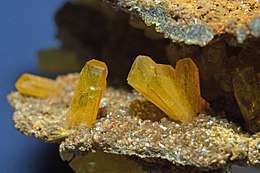Legrandite
| Legrandite | |
|---|---|
 | |
| General | |
| Category | Arsenate minerals |
| Formula (repeating unit) | Zn2(AsO4)(OH)·(H2O) |
| Strunz classification | 8.DC.10 |
| Crystal system | Monoclinic |
| Crystal class |
Prismatic (2/m) (same H-M symbol) |
| Space group | P21/c |
| Unit cell |
a = 12.805(2), b = 7.933(1) c = 10.215(2) [Å]; β = 104.23°; Z = 8 |
| Identification | |
| Color | Bright yellow, wax-yellow, colorless |
| Crystal habit | Crystalline, prismatic, typically in sprays or sheaflike aggregates |
| Cleavage | Imperfect, poor one {100} |
| Fracture | Conchoidal |
| Tenacity | Brittle |
| Mohs scale hardness | 4.5-5 |
| Luster | Vitreous |
| Streak | White |
| Diaphaneity | Transparent to translucent |
| Specific gravity | 3.98–4.01 |
| Optical properties | Biaxial (+) |
| Refractive index | nα = 1.675 - 1.702 nβ = 1.690 - 1.709 nγ = 1.735 - 1.740 |
| Birefringence | δ = 0.060 |
| Pleochroism | X = Y = Colorless to yellow Z = Yellow |
| 2V angle | Measured: 50° |
| References | [1][2][3] |
Legrandite is a rare zinc arsenate mineral, Zn2(AsO4)(OH)·(H2O).
It is an uncommon secondary mineral in the oxidized zone of arsenic bearing zinc deposits and occurs rarely in granite pegmatite. Associated minerals include: adamite, paradamite, köttigite, scorodite, smithsonite, leiteite, renierite, pharmacosiderite, aurichalcite, siderite, goethite and pyrite.[1][2] It has been reported from Tsumeb, Namibia; the Ojuela mine in Durango, Mexico and at Sterling Hill, New Jersey, US.[1]
It was first described in 1934 for an occurrence in the Flor de Peña Mine, Nuevo León, Mexico and named after M. Legrand, a Belgian mining engineer .[2]
References
| Wikimedia Commons has media related to Legrandite. |
This article is issued from
Wikipedia.
The text is licensed under Creative Commons - Attribution - Sharealike.
Additional terms may apply for the media files.